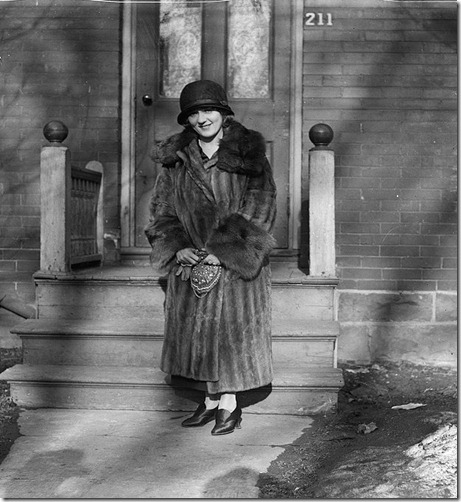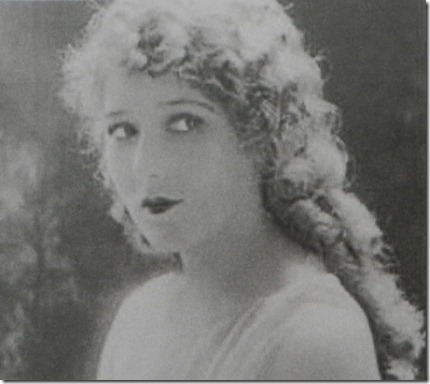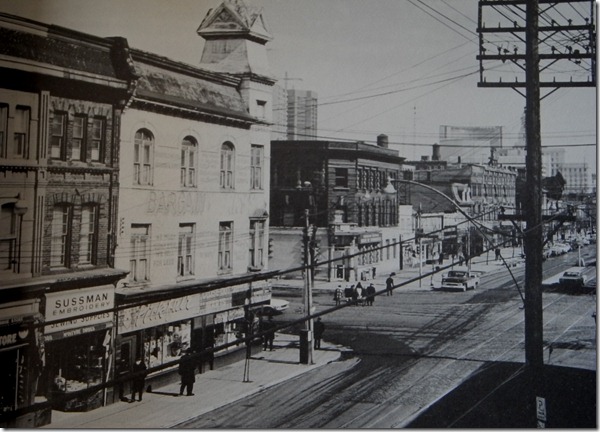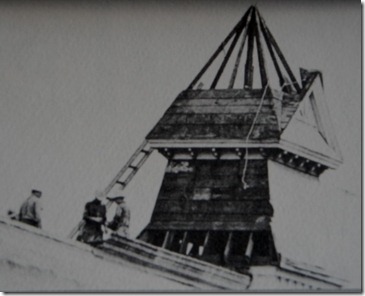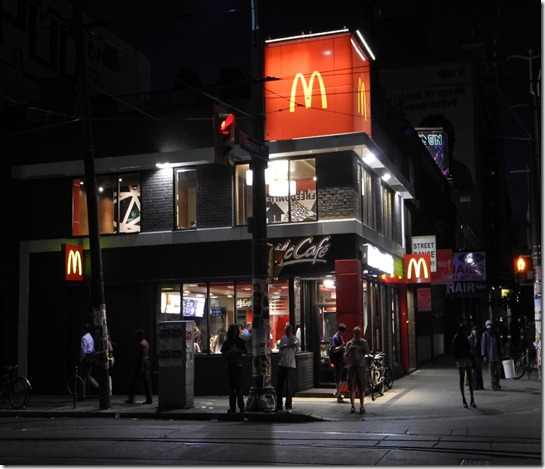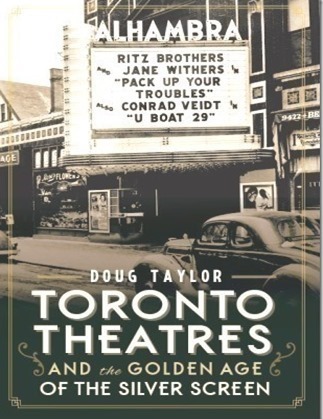When gazing at the intersection at Queen and Spadina, where a McDonald’s is located on the northwest corner, it is difficult to believe that this site was at one time beyond the western boundary of the city. When Toronto was incorporated in 1834, and its name changed to York, the city only extended as far as Peter Street.
A map of 1797 reveals that the site of the intersection was originally part of the Military Reserve, attached to Fort York. As late as 1867, the northwest corner of Queen and Spadina was part of a large estate named “The Meadows.” There were three structures on the property, likely a house, a barn, and another out-building.
An 1890s map shows that the land on the north side of Queen had been divided into building lots. Lot #1 was the site of today’s MacDonald’s, and its postal number was 432. In 1908, the Mary Pickford Theatre was constructed on the site. It was renamed the Avenue theatre in 1913, but its name reverted to its original title in 1915.
The above photo from the Toronto Archives looks north on Spadina from the intersection at Queen Street on 23 September 1910. The building on the right-hand side remains today, and is a branch of the CIBC. The building on the left-hand side is the Mary Pickford Theatre. The tower on the theatre complemented the one on the southeast corner, which remains in existence today and is now another hamburger outlet.
This 1910 photo from the Toronto Archives is a view of Queen Street looking west toward Spadina. On the southeast corner of Spadina and Queen is the building that remains in existence today, with its turret that complemented the one of the Mary Pickford Theatre. On the left-hand side of the photo is the south-facing facade of the theatre. On the southwest corner, where a bank is now located, was a coal-yard in 1910.
The entrance of the Mary Pickford Theatre in the early months of 1910. The movie the “Heroine of Mafeking” was released on 11 December 1909. The entrance of today’s MacDonald’s is where the support pillar in the foreground is located. During the First World War, the theatre entertained the troops that were training in Toronto prior to being shipped overseas.
The theatre was owned by C. Rotenberg, and continued to operate throughout the 1930s, showing an eclectic mixture of films, from Hollywood movies to those from the Soviet Union. The third floor of the theatre housed the Leonard Athletic Centre, where local boxers like Sammy Luftspring trained. In the 1950s the theatre became the Variety Theatre and screened controversial films such as “Salt of the Earth,” which had been banned in the U.S. during the McCarthy witch hunt.
The picture above shows Mary Pickford, the famous movie star, in front of the home where she was born in 1892, at 211 University Avenue. Sick Children’s Hospital is now on the site, and an historic plaque marks the location of he birthplace. Mary Pickford married Douglas Fairbanks in 1920. This photo was taken on 24 March 1924, and is from the Toronto Archives.
Mary Pickford
In the 1950s the theatre became a bargain emporium named “Bargain Benny’s” that was famous for its extravagant signs and wall paintings. This photo was taken in 1969, when the store was highly popular with downtown shoppers.
In 1972 the previous site of the Mary Pickford Theatre and later the home of Bargain Benny’s, was demolished. This photo depicts the workmen removing the tower from the structure. The above tow photos are from the book, “Spadina Avenue,” by Rosemary Donegan.
Queen and Spadina after dark.
To view the Home Page for this blog: https://tayloronhistory.com/
To view previous posts about movie houses of Toronto—old and new
https://tayloronhistory.com/2013/10/09/links-to-toronto-old-movie-housestayloronhistory-com/
To view links to other posts placed on this blog about the history of Toronto and its heritage buildings:
https://tayloronhistory.com/2013/10/08/links-to-historic-architecture-of-torontotayloronhistory-com/
Recent publication entitled “Toronto’s Theatres and the Golden Age of the Silver Screen,” by the author of this blog. The publication explores 50 of Toronto’s old theatres and contains over 80 archival photographs of the facades, marquees and interiors of the theatres. It also relates anecdotes and stories from those who experienced these grand old movie houses.
To place an order for this book:
Theatres Included in the Book
Chapter One – The Early Years—Nickelodeons and the First Theatres in Toronto
Theatorium (Red Mill) Theatre—Toronto’s First Movie Experience and First Permanent Movie Theatre, Auditorium (Avenue, PIckford), Colonial Theatre (the Bay), thePhotodome, Revue Theatre, Picture Palace (Royal George), Big Nickel (National, Rio), Madison Theatre (Midtown, Capri, Eden, Bloor Cinema, Bloor Street Hot Docs), Theatre Without a Name (Pastime, Prince Edward, Fox)
Chapter Two – The Great Movie Palaces – The End of the Nickelodeons
Loew’s Yonge Street (Elgin/Winter Garden), Shea’s Hippodrome, The Allen (Tivoli), Pantages (Imperial, Imperial Six, Ed Mirvish), Loew’s Uptown
Chapter Three – Smaller Theatres in the pre-1920s and 1920s
Oakwood, Broadway, Carlton on Parliament Street, Victory on Yonge Street (Embassy, Astor, Showcase, Federal, New Yorker, Panasonic), Allan’s Danforth (Century, Titania, Music Hall), Parkdale, Alhambra (Baronet, Eve), St. Clair, Standard (Strand, Victory, Golden Harvest), Palace, Bedford (Park), Hudson (Mount Pleasant), Belsize (Crest, Regent), Runnymede
Chapter Four – Theatres During the 1930s, the Great Depression
Grant ,Hollywood, Oriole (Cinema, International Cinema), Eglinton, Casino, Radio City, Paramount, Scarboro, Paradise (Eve’s Paradise), State (Bloordale), Colony, Bellevue (Lux, Elektra, Lido), Kingsway, Pylon (Royal, Golden Princess), Metro
Chapter Five – Theatres in the 1940s – The Second World War and the Post-War Years
University, Odeon Fairlawn, Vaughan, Odeon Danforth, Glendale, Odeon Hyland, Nortown, Willow, Downtown, Odeon Carlton, Donlands, Biltmore, Odeon Humber, Town Cinema
Chapter Six – The 1950s Theatres
Savoy (Coronet), Westwood
Chapter Seven – Cineplex and Multi-screen Complexes
Cineplex Eaton Centre, Cineplex Odeon Varsity, Scotiabank Cineplex, Dundas Square Cineplex, The Bell Lightbox (TIFF)
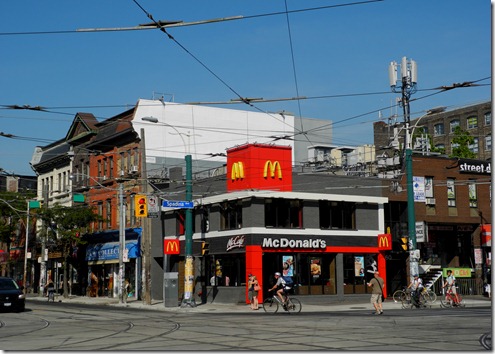
![f1231_it2046[1] f1231_it2046[1]](https://tayloronhistory.com/wp-content/uploads/2012/08/f1231_it20461_thumb.jpg)
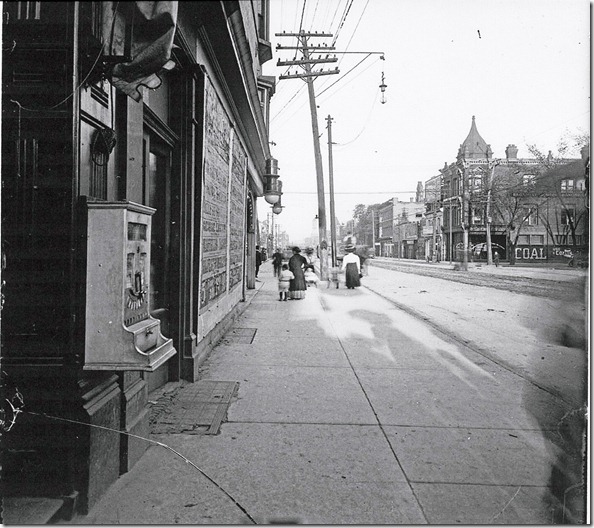
![f1244_it0320c[1] f1244_it0320c[1]](https://tayloronhistory.com/wp-content/uploads/2012/08/f1244_it0320c1_thumb.jpg)
